| LM SUGARBUSH LLC ~~ VIRTUAL TOUR |
Without leaving the comfort of your classroom or home you can visit us at
LM SUGARBUSH LLC and watch as we tap our maple trees and produce pure maple syrup here in Southern Indiana. School classes and homeschoolers can use this as a Virtual Field Trip without even venturing out into the cold weather.
Although our production season is limited to January, February, and March each year, we stay busy at the farm year round! This virtual tour will walk you through our season in chronological order, beginning in October. Hope you enjoy!!
|
| PRE-SEASON PREPARATION - OCTOBER-JANUARY |
Starting in late October, or weather permitting, the guys begin to cut firewood. Our evaporator is 100% wood fired. As you can imagine, we go through a lot of wood! Robert estimates that we go through 75-90 ricks of wood each year. Our wood fired evaporator is unique - most larger operations now use diesel powered evaporators. We still do it the old way!
The addition of the Kubota tractor and a gas powered wood splitter in 2013 have greatly improved the efficiency of our firewood collection process. Robert and Nic cut fallen trees up or cut down damaged or dead standing trees. They will chain the large logs to the tractor and haul the trees back to the Sugarhouse. The trees are then cut down to size (about 2’ long) and split into manageable pieces.
|
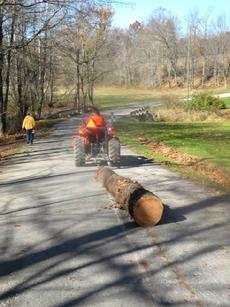 |
| Hauling logs with the tractor |
|
|
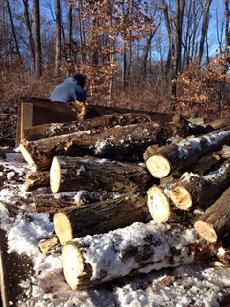 |
| Cutting up a fallen tree |
|
|
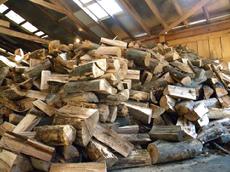 |
| Lots of split wood, ready for the evaporator |
|
|
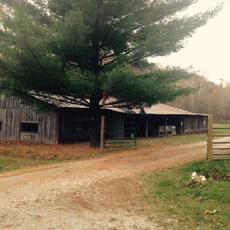 |
| The Sugarhouse |
|
|
In late December and early January of the new season, we go through the sugarbush pulling the tubing out of the previous fall's leaf cover. We will haul loads of repair tubing and main line to the sugarbush to begin the process of repairing and maintaining the sap collection lines to ready them for the syrup season. The squirrels have chewed on the tubing, there has been damage to the main lines by falling branches, and just time itself takes a toll on the lines.
| |
In addition to the work in the woods there is a lot to do at the sugarhouse. We must clean the evaporator and the Reverse Osmosis machine. The RO machine removes up to 50% of the water from the sap before we boil it. All the storage tanks need to be cleaned and some minor repairs need to be made on other equipment. We will begin to tap when the weather is right - this varies from year to year. The best sap weather is 45 - 50 degrees during the day, with some sun and 20 - 25 degrees at night. It takes us 3-4 days and 5 tapping crews to tap our entire sugarbush.
| |
|
| TAPPING - FEBRUARY & MARCH |
Tapping our trees is a very labor intensive process. Using gas powered tappers, we drill a small hole for each spile. Each tree will get 1-4 spiles, depending on the tree’s size. The taps are made in a different spot each year, allowing the trees to heal from each previous season. Each hole is about 7/16” in diameter and about 1 ½ inches deep. The hole in the tree exposes a very small portion of the tree’s sap layer. The sap will flow out of the tree, through the spile, and into the tubing system. We use a vacuum system to gently pull the sap through the tubing system into holding tanks.
We generally put one tap in trees at least 12 inches in diameter, two taps in trees 14 inches in diameter, three taps in trees at least 18 inches in diameter, and four taps for any trees at least 24 inches in diameter.
Our tapholes will generally last 3-7 weeks, depending on the weather. If the weather is still favorable for sap production at the end of the life cycle for the tapholes, we may re-tap the sugarbush for an extended season. Warm weather causes the tapholes to dry out and heal faster.
| |
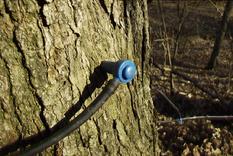 |
| A newly tapped maple tree |
|
|
| SAP COLLECTION - FEBRUARY & MARCH |
When the sap is flowing we turn on the vacuum pumps and check the entire tubing system for leaks. First, the mainline is checked, then we check the lateral lines that go to the individual trees. We check for damage from falling tree limbs and squirrels. The squirrels like to chew on the tubing, leaving holes for the sap to leak from and destroying the vacuum on the system.
Our Sugarbush has about 3300 tapholes in 1600 trees, more than 10 miles of tubing and about 1 1/2 miles of main line.
| |
|
| BOILING - FEBRUARY & MARCH |
After the sap is collected in the holding tanks in the sugarbush, we transfer the sap to our sugarhouse, using a holding tank pulled by our tractor. The raw sap runs through our reverse osmosis machine, which removes up to 50% of the water from the sap. This greatly reduces our boiling time. During a big run, we sometimes boil through the night in order to keep up with the flowing sap.
After flowing through the reverse osmosis machine, the sap is fed into our wood fired evaporator. The syrup is boiled until it reaches 218 degrees (7 degrees above the boiling point of water). We will also use a hydrometer to test the density of the syrup. On average, it takes 45/55 gallons of sap to produce one gallon of pure maple syrup.
| |
When the syrup has reached the appropriate temperature and density, we will “draw off” the syrup into small 5 gallon pails. Each draw off ranges from 9-12 gallons. On average, it will take 3-5 hours of intense boiling to turn raw sap into finished syrup. We grade the syrup after it has cooled and store it in large 55 gallon drums.
|
We still hand bottle 100% of our maple syrup on the farm. The finished syrup is reheated to 180 degrees and runs through a complex filtration process to remove any impurities. It is very important that the syrup is at the correct temperature when we bottle to achieve a proper seal on the jugs.
|
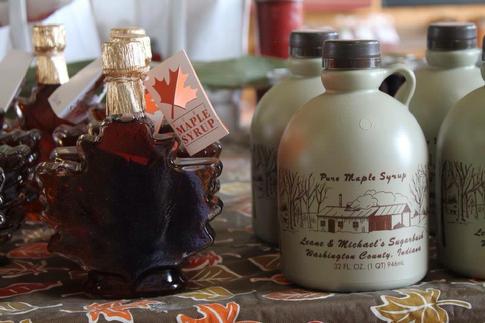 |
| Glass and Plastic Containers |
|
|
| MAPLE SYRUP FESTIVAL - FEBRUARY & MARCH |
Our Maple Syrup Festival is held every year in February and March. This event draws 8,000-10,000 people over four days. All of the buildings are thoroughly cleaned, children’s activities are prepared, kitchen staff and food inventory are coordinated, vendors are scheduled, and a large quantity of syrup is bottled. It is a very busy time of year for us and we are thankful for all of our hard working staff. It takes a village to run a successful festival!
| |
| END OF SEASON - EARLY MARCH |
At the end of the season, usually in late March, we will pull all of the spiles out of the trees. We leave our tubing system in the woods year round. Each spile will be fitted with a plug. We rinse our tubing system with a formula of water and apple cider vinegar. The holding tanks in the sugarbush are carefully cleaned and turned upside down. The vacuum pumps are returned to the sugarhouse and stored until the next season. The evaporator is cleaned and the RO machine in flushed. Everything is carefully cleaned and packed away, ready for the next season to begin.
|
Starting in April, after recovering from a long syrup season and a busy festival, the grass begins to grow. We spend most of the summer mowing grass, bottling syrup in small batches for our customers, and hosting several open house days at the farm. We perform routine maintenance on all of our equipment in the summer (no frozen fingers!!). We take this time to review our past sugaring season and make improvements for our next season.
|
Fall is a beautiful time of year at the farm. The leaves are spectacular. When the weather starts to cool, we begin another season. This year (2014-2015 season) will be 33rd consecutive year making maple syrup on our farm.
|
|